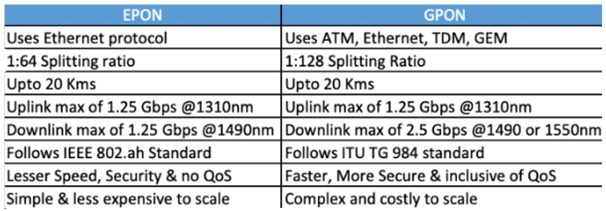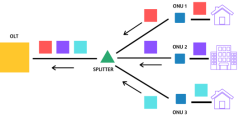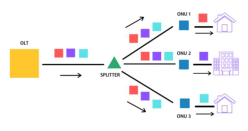Understanding the Role of PON in Fiber Optic Network
In today’s connected world, technologies that can communicate, transfer and analyze data are required in every infrastructure, right from Enterprises to Hospitals to Schools to Hotels to smart cities. At the heart of these is the Fiber Optics Network that promises both high speeds and long-haul delivery. FTTH (Fiber to the Home), FTTC (Fiber to the Cabinet) and FTTN (Fiber to the Node) are all examples of FTTx network architectures that aim to provide what was thought of as impossible through copper media at one time – high availability alongside high speeds and long distances.
Under Fiber Optics Network, FTTx (Fiber To The X) and PON (Passive Optical Networks) are terms that are often used interchangeably. Thus, it is important to note that FTTx is the connection of Fiber cable until the homes, businesses and other establishments while PON is the actual technology used to provide services (Telephone, TV, internet etc.) on the connected fiber.
Understanding PON & Types:
A PON is a point to multipoint, passive architecture used by carriers and service providers for providing long haul, last mile connectivity to subscribers. Typical components of a PON implementation include below elements:
- Optical Line Terminal (OLT) – Central Office
- Optical Network Unit (ONU) – Subscriber premise
- Passive Optical Splitter – Subscriber side
The most common types of PON you are likely to see in today’s and future carrier infrastructures are
- GPON (Gigabit Capable Passive Optical Network)
- GEPON (Gigabit Ethernet Passive Optical Network)
These are very similar in many respects yet differ in ways that are important to understand.
GPON Vs GEPON

How GPON/GEPON Works?
GPON/GEPON uses WDM (Wavelength Division Multiplexing) to ensure bidirectional communication for multiple users over a single fiber. To separate downstream and upstream signals of multiple users over a single fiber:
-
-
- Downstream data is broadcasted.
- Upstream data is transmitted via TDMA.
- Upstream

Upstream works on the principle of Time Division Multiple Access (TDMA) where each user device is given a time slot to upload. Given the bursty nature of upstream traffic, this works out just fine. Upload speeds as high as 1.25 Gbps are supported on a wavelength of 1310 / 1550nm.
- Downstream
-

Downstream communication operates through Broadcasts. The OLT will send every frame to each subscriber, however the ONU filters out frames not relevant to the specific user. Download speeds of upto 2.4 Gbps are achievable downstream over a wavelength of 1490nm for GPON and upto 1.25 Gbps in case of GEPON.
GPON & GEPON are currently the ring leaders and here to stay the course for a very long time. If you are looking to upgrade your infrastructure to Fiber optics then you are at the right place. Digisol Systems, a leading provider of IT Networking Products offers the finest-in-class GPON, GEPON equipment and Fiber cabling.
Check out our complete FTTH solution matrix: www.digisol.com/ftth-solutions/
